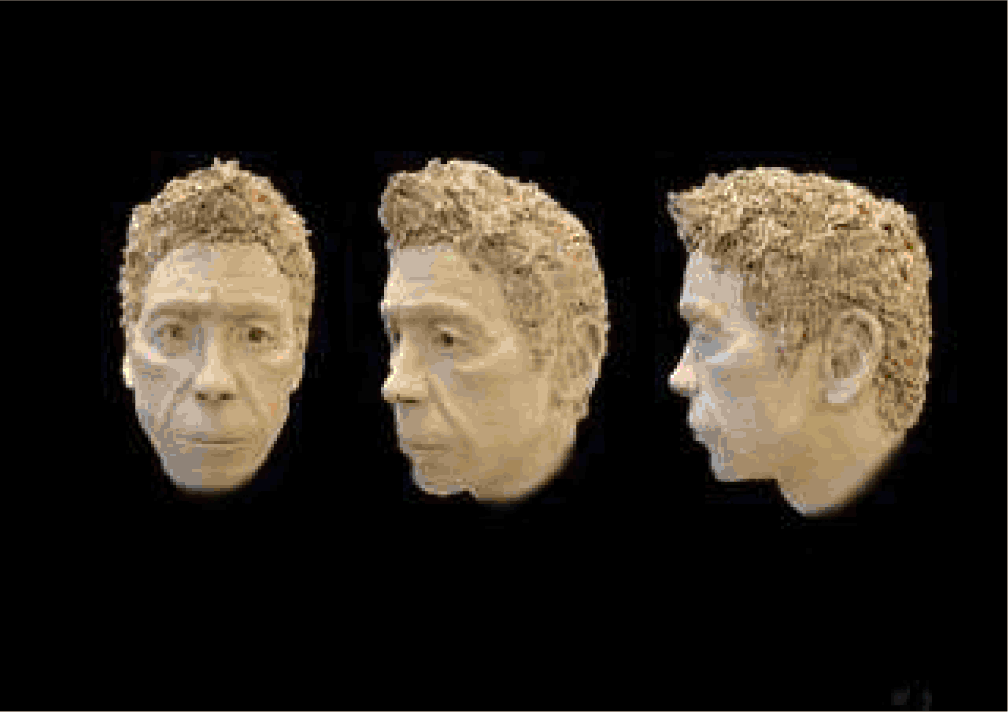Three views of artist's bust rendition

Legend: Photograph provided by the “Sculpture for Surgeons”
Natalia Katarzyna Bober1
doi: http://dx.doi.org/10.5195/ijms.2019.435
Volume 7, Number 3: 95-96
Received 25 09 2019: Rev-recd 19 10 2019: Accepted 15 09 2019
“Sculpture for Surgeons“ was a three-day course hosted in London and led by Luke Shepherd, a professional sculptor. During that time, each of the participants created a bust of the human model from scratch (Figure 1). This course was mainly aimed at surgeons to improve their appreciation of facial anatomy and help in future operations. However, the event welcomed medical professionals at various stages of training. I met plastic trainees and consultants, as well as medical students and junior doctors. Each of us had a different experience with sculpting. Some of us, like me, never touched the clay before; others were sculpting regularly. We all started together and step by step Luke Shepard led us through the meticulous steps of capturing the complexity of facial topography.
Figure 1Three views of artist's bust rendition

It all started with the most difficult step: observation. We often consider ourselves good observers, able to spot details and nuances. However, how good are we though when it comes to three-dimensional observation? We tend to fixate on two-dimensional pictures, forgetting about the depth. For instance, we know that the ear is located behind the temporomandibular joint, but how high is it in relation to the eye? At what angle is it? Which part of the pinna is the most distal? These were only some of the questions I tried to answer, which I had never thought about before. Only later did I realize that observing and analyzing took me, in fact, more time than the actual sculpting. While it might be relatively easy to create a face, the real difficulty lies with the accurate recreation of the actual model.
The next step involved translating observation into sculpture, which required unbelievable precision. We received countless advice on how to approach it and how to get the most precise measurements using only pencils and calipers, to maintain the realistic dimensions of the sculpture. Each day we were being taught more advanced steps. From creating the profile on day one, to tips on shaping the eyes on day three, Luke Shepard was an extremely supportive teacher. He allowed us to discover an artist and careful observant in each of us. After demonstrations of subsequent steps, he would always take a tour around the room to see up close how we were getting on. Whenever he came towards my sculpture, this gave me a chance to reflect on my work. I was grateful for all the tips, and it definitely helped me develop a more critical eye.
Nowadays, the practical workshops incorporated into medical education tend to be limited to absolutely necessary skills such as cannulations or suturing, with many students complaining about the lack of hands-on experience.1 I personally believe there is a strong emphasis on knowledge of theory, with scarcity of manual development opportunities, let alone creative or artistic workshops. There is increasing interest and need for this type of activities to be incorporated into medical curriculum.
For example, Gelgoot et al. carried out a literature review on this topic and found some promising responses.2 This included university courses using discussions over paintings as a way of reflecting on topics such as mental illness, doctor-patient relationship, suffering and death. Penn State, Harvard and UT Austin are among the universities incorporating humanities into medical education.3 Many argue that it is essential for the development of communication and interpersonal skills, as well as critical thinking. In fact, studies are showing that exposure to visual arts leads to positive personal qualities such as empathy and can reduce burnout among the medical students.4 Practical art courses including drawing and sculpting, such as the Art of Anatomy and Surgery SSC Course organized at King's College London, were shown to improve dexterity, personal expression and medical knowledge.
Incorporation of art into medicine has numerous benefits. Not only does it contribute to personal development and improvement of numerous skills such as observation or imagination, but it also allows for the valuable insight and understanding of the patients’ experience. Opportunities for medical students are constantly expanding, yet not all medical programs offer a variety of humanities courses. That is why I am absolutely grateful for having the chance to attend the “Sculpture for Surgeons” event. I found the course to be an invaluable experience and a great self-development opportunity. It definitely improved my understanding of the complexity of facial anatomy and most importantly, it contributed to my observation skills, which are crucial for every doctor.
Student ticket subsidized by the Sculpture for Surgeons organizing team.
The Authors have no funding, financial relationships or conflicts of interest to disclose.
Conceptualization: NKB. Writing – Original Draft: NKB.
1.Write 1. Socea B. Students’ Surgical Training - A Continuous Challenge. Int J Med Students. 2018 Sep-Dec;6 (3):132–133.
2.Gelgoot E, Caufield-Noll C, Chisolm M. Using the visual arts to teach clinical excellence. MedEdPublish. 2018;7 (3).
3.Lesser C. Why Med Schools Are Requiring Art Classes [Internet]. Artsy. 2019 [cited 10 November 2019]. Available from: https://www.artsy.net/article/artsy-editorial-med-schools-requiring-art-classes. Last accessed: Dec 17, 2019
4.Mangione S, Chakraborti C, Staltari G, Harrison R, Tunkel A. Medical Students’ Exposure to the Humanities Correlates with Positive Personal Qualities and Reduced Burnout: A Multi-Institutional U.S. Survey. J Gen Intern Med. 2018 May;33 (5):628–634.
Natalia Katarzyna Bober, 1 Medical student, King's College London GKT School of Medical Education, UK
Mihnea-Alexandru Găman, Editor
About the Author: Natalia Katarzyna Bober is currently a fifth-year medical student at King's College London GKT School of Medical Education, UK.
Correspondence: Natalia Katarzyna Bober, Address: Strand, London WC2R 2LS, UK. Email: natalia.bober@kcl.ac.uk
Cite as: Bober NK. Sculpture for Surgeons. Int J Med Students. 2019 Sep-Dec;7(3):95-6.
Copyright © 2019 Natalia Katarzyna Bober
This work is licensed under a Creative Commons Attribution 4.0 International License.
International Journal of Medical Students, VOLUME 7, NUMBER 3, December 2019